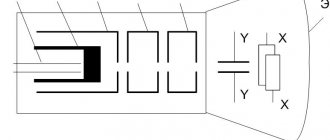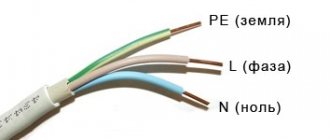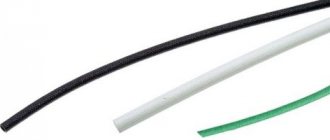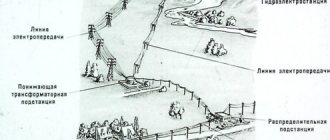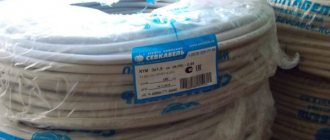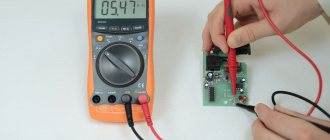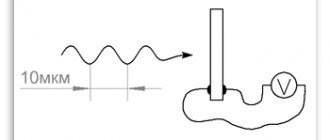A measuring device is a device with which the measured quantity is compared with a unit of measurement. The measuring device is designed to generate a signal of measuring information in a form accessible to direct perception by an observer.
Measuring instruments are divided into exemplary and working.
Samples are instruments intended for storing and reproducing units of measurement, as well as for checking the calibration of instruments.
Workers are instruments used for practical measurements. In turn, working measuring instruments are divided into laboratory and technical. Laboratory instruments are not used in industry and therefore are not considered further. For automatic control and regulation in industry, technical working instruments are used.
According to their purpose, technical working instruments are divided into indicating, recording, signaling, regulating and measuring machines. Indicating devices are devices that only count the measured value at a given moment in time. Recording (recording) instruments are equipped with a device for automatic registration (recording) of the value of the measured quantity during the entire operation of the device.
They make it possible to obtain data for subsequent analysis of the operation of an object or the progress of a technological process by processing a cartogram of the device. Self-recording devices may also have a indicating device, in which case they are simultaneously indicating and recording. Signaling devices have special devices for turning on a light or sound alarm when the measured value reaches a predetermined value. Control devices have a special device designed to automatically maintain the measured value at a given value or to change it according to a given law.
Such devices may have a indicating or recording device, or both at the same time. Measuring machines are devices with a device that performs certain work based on the measurement results, according to the program established for them. They are used for weighing and dosing liquid and bulk substances, controlling the operation of technological equipment, sorting products and other operations. Based on the nature of transmission of readings, instruments are divided into local and remote transmission. Local instruments, by their design, can only be used directly at the measurement site.
For devices with remote transmission, the actuating part is located at a considerable distance from the measurement location. Devices with remote transmission are assembled into measuring installations, which consist of the following main parts:
- a primary device - a transducer (sensor), which perceives, through a sensitive element (primary transducer), changes in the measured quantity, converts it into an output signal - a pulse and transmits the latter to a distance; a secondary device, which perceives, through a measuring device, pulses transmitted by the transducer, and converts them into moving the pointer relative to the scale; secondary devices can be indicating, recording, signaling, regulating devices or automatic measuring devices; connecting pipes (pneumatic, hydraulic) or electrical wiring through which measurement results are transmitted from the converter to the secondary device.
Congratulations, you get a 10% discount within an hour
Tags: tools
There are a huge variety of measuring instruments. According to their purpose, they are all conditionally divided into two groups: direct action and comparison.
The first ones display the measured value on a indicating device; these include thermometers, ammeters, voltmeters, etc.
The second are intended to compare the measured value with one whose value is known. They are used primarily for scientific purposes, but in practice they are used to measure compressed air pressure, radiation sources, etc.
General information
A measuring device is a device that allows you to obtain the value of a certain physical quantity in a given range. The latter is set using an instrument scale. Technical devices also make it possible to convert values into a more understandable form that is accessible to a specific operator.
Currently, the list of measuring instruments is quite wide, but most of them are intended for monitoring the technological process . This could be a temperature or cooling sensor in air conditioners, heating furnaces and other devices with a complex design.
Among the names of measuring instruments there are both simple and complex, including in design. Moreover, the scope of their application can be both highly specialized and widespread.
To find out more information about a specific instrument, it is necessary to consider a certain classification of control and measuring devices and instruments.
Documentation
A technical device is a set of qualities that allow it to be used in any field. Production and operation are determined by the rules and technological requirements described in the documentation supplied with each device.
Basic documents included in the package:
- Passport products. It indicates the technical characteristics of the device, expressed in calculated units of performance, energy consumption, etc. The passport is often supplemented with information about the condition of the equipment, repairs performed, warranty period of service, etc.
- Manual. The document describes the principle of operation, scope of application, storage and operation rules, methods of disposal and transportation.
- Instructions for installation, start-up, regulation, running-in. The document is compiled for industrial devices with special operating conditions.
- Label. Placed directly on the product if the necessary data for operation and startup contains no more than five points and there is no point in creating a passport.
Any technical device is a unit of production manufactured industrially. The documentation for it must comply with the standards prescribed in the ESKD, ESPD or ESTD.
Types of measuring instruments
Depending on what kind of measuring instruments there are, their names may differ in different classifications.
Typically, devices can be of the following type:
- Analog measuring instruments and devices in which the output signal is some function of the quantity being measured.
- Digital devices where the output signal is presented in the appropriate form.
- Instruments that directly record the results of measurements taken.
- Summing and integrating. The former provide readings as the sum of several quantities, while the latter allow you to integrate the value of the measured quantity using another parameter.
The instruments described above are the most common and are used to measure a number of physical quantities. The complexity of the physical processes occurring requires the use of several instruments classified into different classes.
Types of unified signals
Large automation systems may use a large number of instrumentation, which requires the use of uniform output signal standards to facilitate operation of the system. Standards accepted in industry unify all instrumentation by type of output signals:
- Analog.
Such instrumentation continuously measures environmental parameters and continuously transmits information in the form of electrical signals - Discrete.
They can be in the form of relays or contactless signaling devices. Work on the 1/0 principle - Interface.
Equipped with a unified data transfer protocol
An analog signal can be in the form of a current - 4...20 mA, or a voltage - 0...10 V. A discrete signal can be classified by voltage - direct or alternating, and by the current strength that the device is capable of passing through itself.
When selecting instrumentation, you need to clearly know what tasks and under what conditions it will perform. This will help you choose the most successful configuration, which will have a positive effect on monitoring the functioning of the system as a whole. the Industrial Automation online store
. Sales engineers will help you make the right choice and advise on equipment operation and care.
Device classification
Different fields have their own classification of devices designed to measure physical quantities.
Devices can be divided according to the following criteria:
- Transformation method: direct action, comparison, mixed transformation.
- According to the method of issuing information, they are divided into showing and recording.
- The type of output information can be represented by either an analog or digital signal.
Recording devices are divided into recording and printing types. The most progressive option is recorders, since they have higher accuracy in providing information and greater opportunities for measuring previously specified parameters.
Indicators
A technical device is a number of qualities and characteristics that fit into the list of properties common to all types of equipment:
- Performance. Any device produces products (processes information), transports, manufactures, etc. per unit of time. The higher the indicator without sacrificing quality, the more efficient the device.
- Reliability. It is determined by the ability to function efficiently and reliably throughout its entire operational life.
- Durability. Includes two concepts - physical and moral wear and tear. Often equipment is capable of performing specified functions, but its operation is no longer economically profitable, since it does not meet safety requirements, energy costs, etc. The emergence of new developments entails replacement with an innovative technical device. New generation equipment often solves a wider range of problems.
- Economical. The ratio of material costs for maintenance, ensuring the operation of devices with the amount of products produced (transportation, processing, etc.).
Improving each indicator is the task of technical progress and is called “modernization”. Over the past few decades, environmental safety indicators, ergonomic characteristics, and the aesthetic component of devices have become relevant. In addition to technical and utilitarian qualities, developers pay attention to ease of use (reduces injuries) and pleasant appearance of devices; some manufacturers focus exclusively on these areas of improvement. Many parameters of the technical means used are regulated by standards at the state level.
Analog and digital
Digital inspection instruments can be either digital or analog. The former are considered more convenient. In them, indicators of force, voltage or current are converted into numbers and then displayed on the screen.
But at the same time, inside each such device there is an analog converter. It is often a sensor that takes and sends readings to convert them into a digital code.
Although analog instruments are less accurate, they are simpler and have better reliability. There are also varieties of analog instruments and devices that include amplifiers and value converters. For a number of reasons, they are preferable to mechanical devices.
Characteristics of optical models
An important characteristic of all optical measurement instruments is the magnitude limits. At the same time, they are assessed both in the longitudinal and transverse directions. In this case, the division price can be determined by two parameters.
First of all, the boundary of the reading device is taken into account, and it is measured in millimeters. In the second case, the number of scales of the goniometer head is taken into account. Among other things, lens magnification can be attributed to important characteristics. The accuracy of measurements is also affected by the diameter of the field of view, which is measured in millimeters.
For pressure and current
Everyone from school or university is familiar with the names of measuring instruments such as barometers and ammeters. The first ones are designed to measure atmospheric pressure. There are liquid and mechanical barometers.
Liquid varieties are considered professional due to the complexity of the design and the features of working with them. Weather stations use barometers filled with mercury inside. They are the most accurate and reliable, allowing you to work under temperature changes and other circumstances. Mechanical designs are simpler, but they are gradually being replaced by digital analogues.
Ammeters are used to measure electrical current in amperes. The ammeter scale can be graduated in standard amperes, as well as micro-, milli- and kiloamperes. It is best to connect such devices in series. In this case, the resistance decreases, and the accuracy of the readings increases.
Energy
Energy is measured using an energy meter. Examples of energy meters include:
- Electric energy meter.
An electricity meter measures energy directly in kilowatt-hours.
- Gas meter
A gas meter measures energy indirectly by recording the volume of gas used. This can be converted into a measure of energy by multiplying it by the heating value of the gas.
Are you an expert in this subject area? We invite you to become the author of the Directory Working Conditions
Locksmith tools
Quite often you can find measuring plumbing tools. The most important characteristic is measurement accuracy. Due to the fact that locksmith tools are mechanical, it is possible to achieve accuracy of up to 0.005 or 0.1 mm.
If the measurement error exceeds the permissible threshold, a violation of the instrument’s operating technology will occur. Then you will need to resharpen the low-quality part or replace the entire unit in the device. Therefore, it is important for a mechanic when adjusting the shaft to the bushing to use tools with greater measurement accuracy rather than a ruler.
The most popular tool with high measurement accuracy is a caliper . But he will not be able to guarantee an accurate result from the first measurement. Experienced workers take several measurements, which are then converted into an average value.
There are operations that require maximum precision. There are many of these in micromachines and individual parts of large-sized devices. Then you should use a micrometer. With it you can measure with an accuracy of hundredths of millimeters. The common misconception that it allows you to measure microns is not entirely true. And when carrying out standard household work, such accuracy may not be useful, since the current values of accuracy and error are sufficient.
Technical breakthrough
The first industrial revolution occurred in the 18th century and brought machines, devices, mechanisms, the development of which we see today. The invention of the steam engine made it possible to put mass production on stream and led to the decline of the artisanal manufacturing method, significantly changing the social structure of society. Created in the 19th century, the internal combustion engine led to the creation and constant improvement of all types of transport. A huge number of self-propelled mechanisms have appeared, exploring space.
New machines were created that significantly simplified road construction, construction and mining work, and so on. The appearance and use of electricity gave impetus to new types of technical devices - this is not only lighting, but also radio engineering, radio electronics, the dream of space exploration has ceased to be unrealistic. The beginning of the 20th century was marked by the introduction of automation of production processes, the first computer technology appeared, and the first artificial satellite was launched into space.
According to experts, the next round of development of technical devices is associated with nanotechnology and biotechnology; promising research and the first achievements in these areas were identified at the end of the 20th century.
